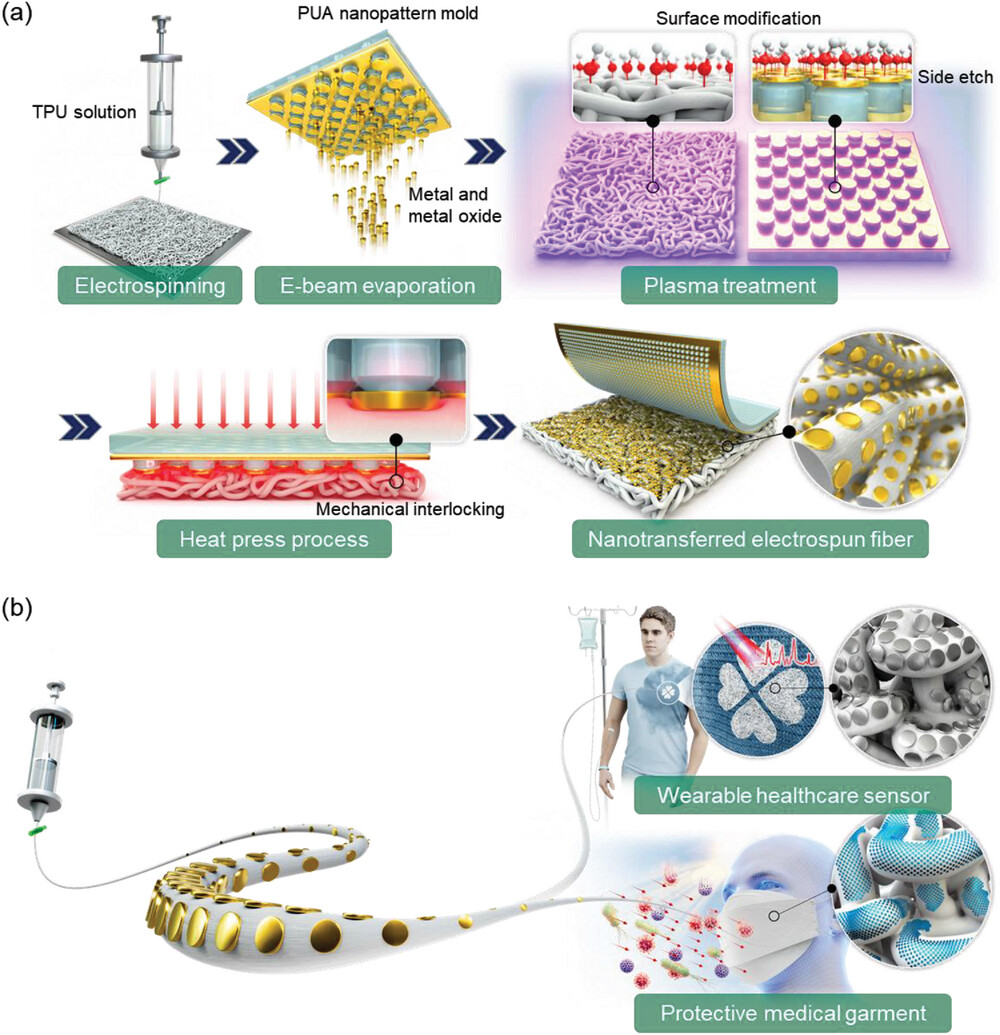| Apr 30, 2024 | |
Nanoprinting turns textiles into multipurpose health monitoring devices |
|
| (Nanowerk Spotlight) In the world of wearable technology, the ultimate goal has been to seamlessly integrate electronic functionality into the fabrics we wear every day. Today, we see a range of devices that hint at this potential, from smartwatches that track our fitness to clothing with built-in haptic feedback for immersive gaming experiences. But despite these advances, many wearable devices still feel like separate gadgets rather than an integral part of our attire. | |
| Smartwatches, for example, often require daily charging and can feel bulky on the wrist, while many smart clothing items rely on visible sensors or wiring that can detract from their aesthetic appeal. Even more advanced products, like leggings with built-in hip-tracking sensors for yoga enthusiasts or jackets with gesture-controlled illumination for cyclists, often struggle to achieve the right balance of functionality, comfort, and durability to make them practical for everyday use. | |
| The challenges in creating truly unobtrusive, wash-and-wear smart clothing are numerous: from maintaining the softness and breathability of traditional fabrics to ensuring reliable, long-lasting performance in the face of repeated stretching, folding, and exposure to sweat and moisture, the bar for successful integration is high. | |
| While progress has been made in fields like flexible electronics and conductive textiles, many current solutions still rely on coating or embedding fabrics with relatively bulky components that can compromise the garment's feel and wearability. Others use specialized materials that require delicate handling or are difficult to integrate with standard manufacturing processes, limiting their potential for widespread adoption. | |
| Now, a team of researchers from Korea has developed a promising new approach that could help clear these hurdles and bring us closer to the next generation of wearable devices. By enabling the precise integration of functional nanomaterials directly into textile fibers, their nanotransfer printing process offers a potential pathway to smart clothing that looks, feels, and wears just like the garments we know and love, but with the added benefits of electronic functionality. | |
| The team’s research has been published in Advanced Functional Materials ("Nanotransfer Printing of Functional Nanomaterials on Electrospun Fibers for Wearable Healthcare Applications"). | |
 |
|
| a) Schematic shows fabrication strategies for transferring nanopatterns onto electrospun fibers. The process involves oxygen plasma treatment of electrospun TPU fibers and M/MO NP molds using the nano imprinting lithography process and E-beam deposition. Subsequently, the nanopatterns are transferred via a heat pressing process. Finally, electrospun fibers with transferred M/MO NPs are fabricated. b) Schematic representation of the research overview. Fabrication of the microscale TPU fiber by ESP and oxygen plasma treatment to improve the adhesion forces. Transfer of the various rationally designed-M/MO NPs to the electrospun TPU fibers. Application 1: The wearable SERS-based sweat sensor patch containing the nanocircular Ag pattern-transferred TPU fibers is attached to general clothing to diagnose diabetes by measurement of the sweat glucose concentration. iv) Application 2: A bactericidal mask containing the TAT nanodot pattern-transferred TPU fibers exhibits bactericidal performance in the visible light region. (Image: Reprinted with permission from Wiley-VCH Verlag) | |
| The key innovation lies in a combination of surface modification techniques and the thermoforming properties of polymers like polyurethane, which allow the researchers to create robust, high-resolution patterns of metals and metal oxides on the microscale fibers produced by electrospinning. The resulting nanopattern-functionalized fabrics exhibit a range of compelling properties, from conductivity and sensing capabilities to antimicrobial activity, all while maintaining the flexibility and breathability that make textiles so well-suited for wearable applications. | |
| To demonstrate the potential of their nanotransfer printing approach, the researchers have created two proof-of-concept devices: a smart patch for non-invasive glucose monitoring and a light-activated antimicrobial face mask. The glucose monitoring patch uses gold nanogap patterns on polyurethane fibers to detect glucose levels in sweat, offering a painless alternative to traditional blood-based testing for diabetes management. The antimicrobial mask, meanwhile, employs silver-doped titanium dioxide nanopatterns to generate reactive oxygen species when exposed to light, providing an extra layer of protection against pathogenic bacteria and viruses. | |
| While these initial prototypes are impressive, they represent just a fraction of the possibilities opened up by this nanotransfer printing technique. By enabling the integration of diverse functional nanomaterials with the scalable production of electrospun fibers, this approach could pave the way for a wide range of smart textile applications, from health monitoring and wound care to environmental sensing and adaptive insulation. And with further refinements to improve pattern fidelity and transfer efficiency over large areas, the prospects for commercialization are promising. | |
| As the field of wearable technology continues to evolve, innovations like this nanotransfer printing method will be crucial in bridging the gap between the lab and the real world. By providing a pathway to seamlessly integrate advanced functionality into everyday garments, without compromising on wearability or durability, this research represents an important step forward in the quest to make smart clothing a practical reality. | |
 By
Michael
Berger
– Michael is author of three books by the Royal Society of Chemistry:
Nano-Society: Pushing the Boundaries of Technology,
Nanotechnology: The Future is Tiny, and
Nanoengineering: The Skills and Tools Making Technology Invisible
Copyright ©
Nanowerk LLC
By
Michael
Berger
– Michael is author of three books by the Royal Society of Chemistry:
Nano-Society: Pushing the Boundaries of Technology,
Nanotechnology: The Future is Tiny, and
Nanoengineering: The Skills and Tools Making Technology Invisible
Copyright ©
Nanowerk LLC
|
|
|
Become a Spotlight guest author! Join our large and growing group of guest contributors. Have you just published a scientific paper or have other exciting developments to share with the nanotechnology community? Here is how to publish on nanowerk.com. |
|
